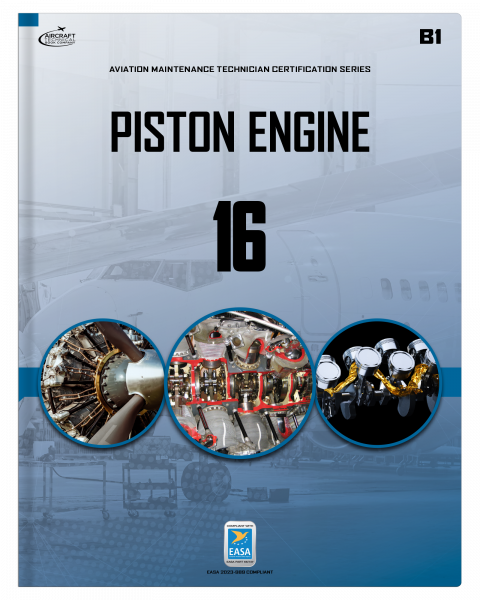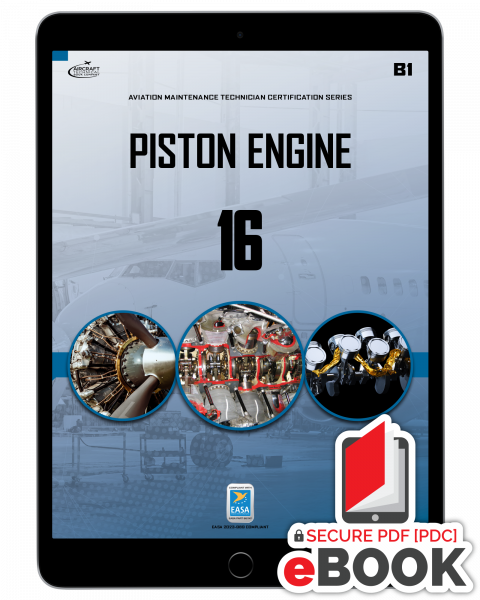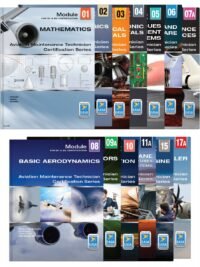Description
EASA Part 66 Module 16 Piston Engines
This book is specifically designed for Aircraft Maintenance Technicians seeking B1.1 and B1.4 certification for airplane and helicopter maintenance. The program outlined in this book aligns perfectly with a typical 2-year, 2400-hour EASA Part 66/147 curriculum.
EASA Part 66 Module 16 Piston Engines strictly adheres to the requirements set forth in Part 66, including content, sequence, and the necessary learning levels (L1, L2, or L3) essential for an approved B1 mechanic maintenance technician program. This module is recognized and approved by numerous national authorities as part of the training frameworks at Part 147 schools within their jurisdictions.
An additional chapter on piston engines, which is not required by EASA, has been included to benefit FAA Part 147 instruction.
Table of Contents:
As prescribed in Part 66 Appendix 1:
- Fundamentals
- Engine Performance
- Engine Construction
- Fuel Systems
- Starting and Ignition Systems
- Induction, Exhaust, and Cooling Systems
- Supercharging/Turbocharging
- Lubricants and Fuels
- Lubrication System
- Engine Indication System
- Powerplant Installation
- Engine Storage and Preservation
- Light Sport Aircraft Engines
Instructor Services:
For educational institutions looking to adopt EASA Part 66 Module 16 as their primary student resource, we offer a range of additional services, including projectable image banks, examination question databases, and extensive support tailored to instructors and the requirements of competent authorities.
More details
Comprehensive Guide to EASA Part 66 Piston Engines
If you’re looking to deepen your knowledge in aviation maintenance, particularly regarding EASA Part 66 piston engines, this guide will provide essential insights and resources. The EASA Module 16 engines focus on various aspects of piston engines, crucial for any aviation technician’s training.
Understanding EASA Module 16 Piston Engine
EASA Module 16 specifically covers the intricacies of piston engine systems. This module is part of the broader Part 66 aviation piston engines curriculum, designed to equip technicians with the necessary skills for effective maintenance and troubleshooting.
The piston engine maintenance EASA course dives into the operational theory and performance of these engines, ensuring technicians can efficiently perform repairs and maintenance. Those undergoing EASA piston engine training will find that the course encompasses practical applications, theoretical knowledge, and a focus on the latest technologies in piston engine technology EASA.
Piston Engine Maintenance and Certification
Understanding piston engine systems Part 66 is vital for anyone aspiring to work in aircraft maintenance. The EASA Part 66 engine certification process ensures that technicians are not only knowledgeable but also capable of applying their knowledge in real-world scenarios.
For effective learning, the module 16 piston engine course includes comprehensive study materials that cover everything from piston engine troubleshooting EASA to piston engine performance EASA. These resources help prepare candidates for the EASA module 16 exam prep, ensuring they are well-equipped to pass the certification exams.
Training and Examination Resources
The EASA Part 66 exam guide is an invaluable tool for candidates. It outlines key topics, including part 66 engine theory, which is foundational for understanding how piston engines operate. This includes aspects of piston engine operational theory and various maintenance techniques required in the field.
Participants in the aviation piston engine course will benefit from hands-on training as well as theoretical instruction. The EASA maintenance training module provides a structured approach to learning about the various components and systems of aircraft piston engines.
Study Resources and Techniques
To excel in your studies, utilizing the right piston engine study materials is crucial. Many resources are available, including online courses, textbooks, and practical workshops. These materials are tailored to cover part 66 aircraft maintenance and ensure that you understand both the theoretical and practical aspects of piston engine maintenance.
Additionally, the EASA engine maintenance technician program emphasizes the importance of continuous learning and practical experience. Engaging with module 16 study resources will further enhance your understanding and retention of critical information.
Conclusion
Embarking on a career in aviation maintenance requires a solid foundation in EASA Part 66 piston engines and associated training modules. Whether you’re studying for the EASA module 16 exam or seeking to improve your skills in piston engine certification EASA, the knowledge gained from these courses is invaluable. With dedicated training, effective study materials, and a focus on part 66 engine regulations, you will be well on your way to becoming a proficient aircraft maintenance technician.
Tags aircraft piston engine module, aviation piston engine course, easa aircraft piston engines, easa engine maintenance technician, easa maintenance training module, easa module 16 exam prep, easa module 16 piston engine, easa part 66 engine certification, easa part 66 exam guide, easa part 66 module training, easa part 66 piston engines, easa piston engine maintenance, easa piston engine training, module 16 easa training, module 16 piston engine course, module 16 study resources, part 66 aircraft maintenance, part 66 aviation piston engines, part 66 engine regulations, part 66 engine theory, part 66 module 16 engines, part 66 module 16 training, piston engine certification easa, piston engine maintenance easa, piston engine operational theory, piston engine performance easa, piston engine study materials, piston engine systems part 66, piston engine technology easa, piston engine troubleshooting easa











Reviews
There are no reviews yet.